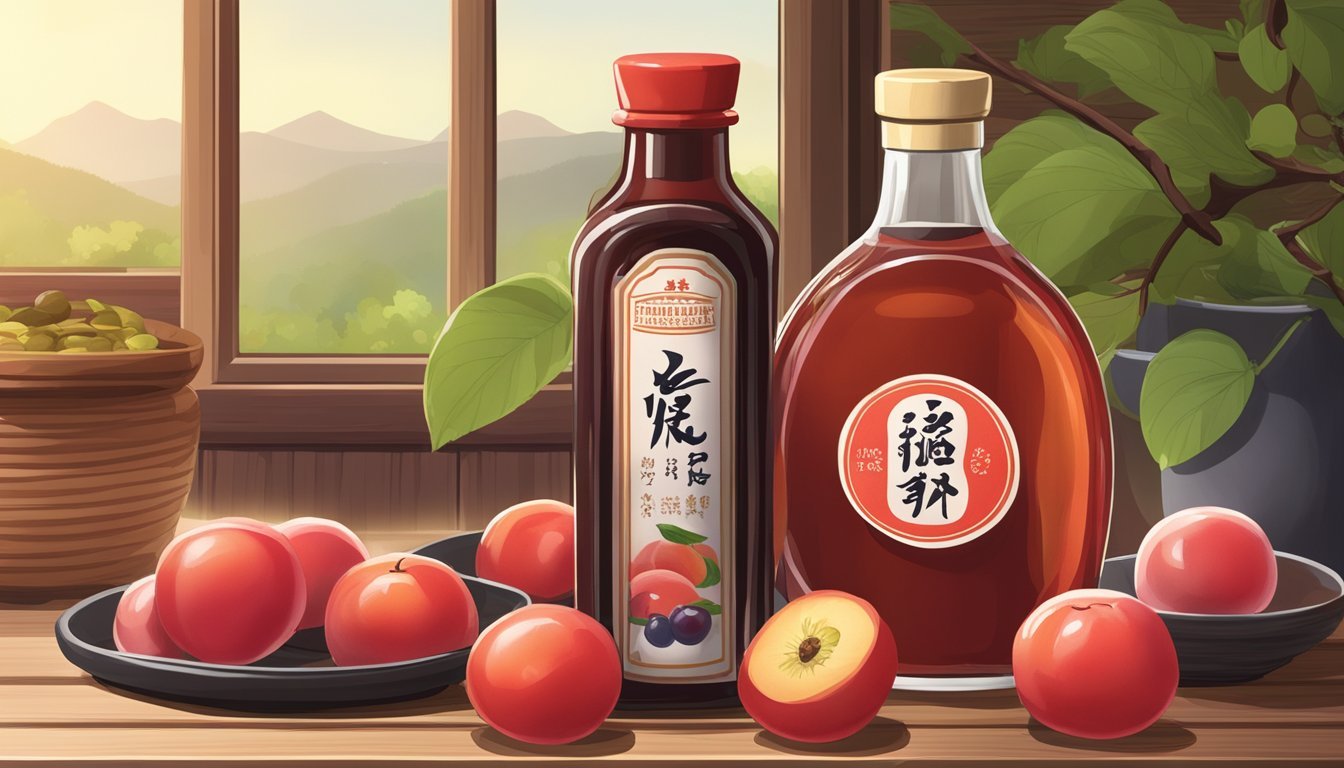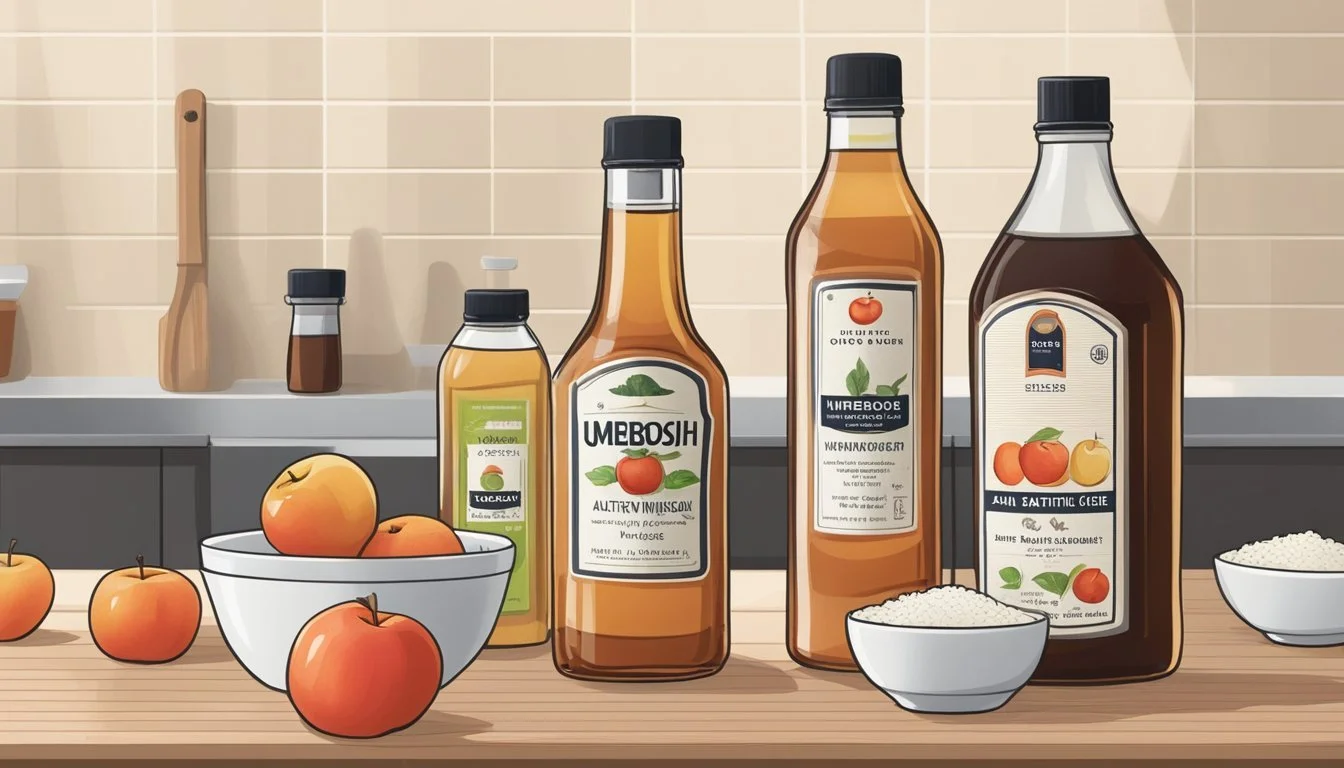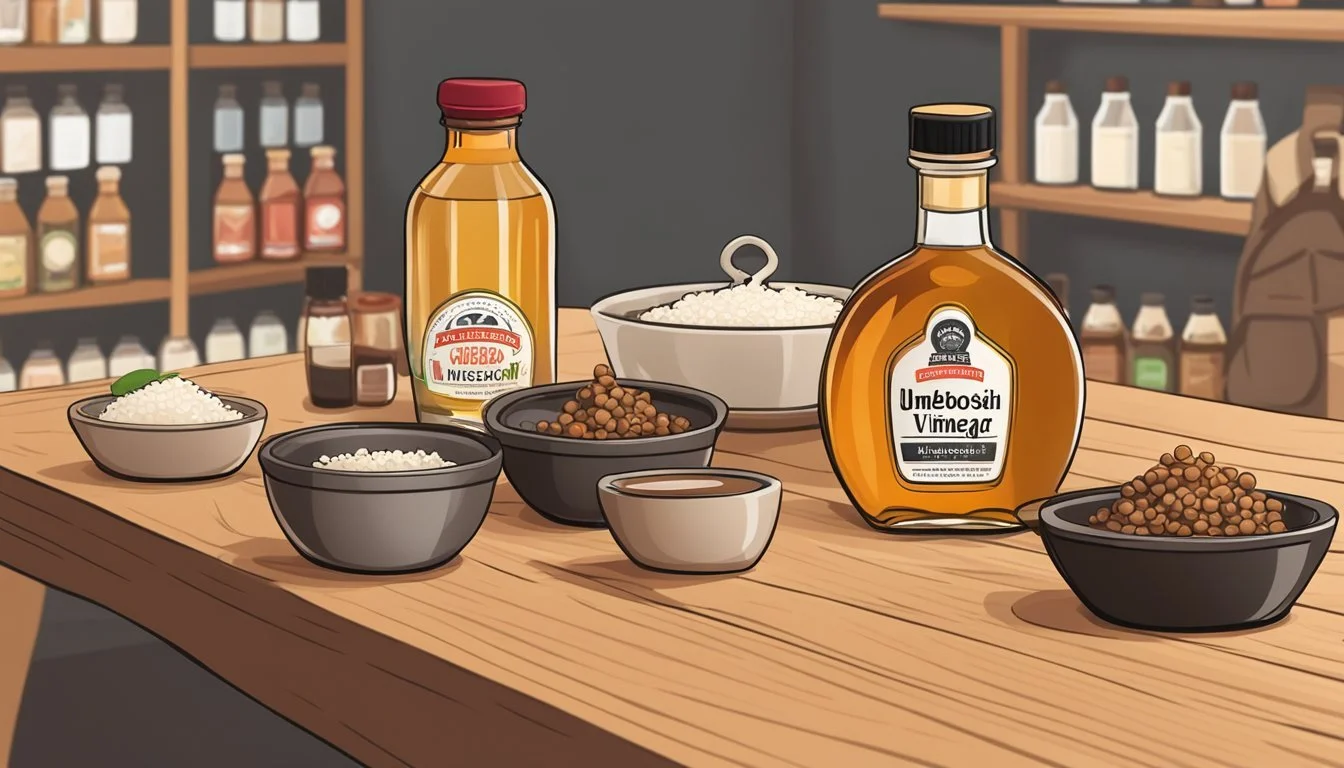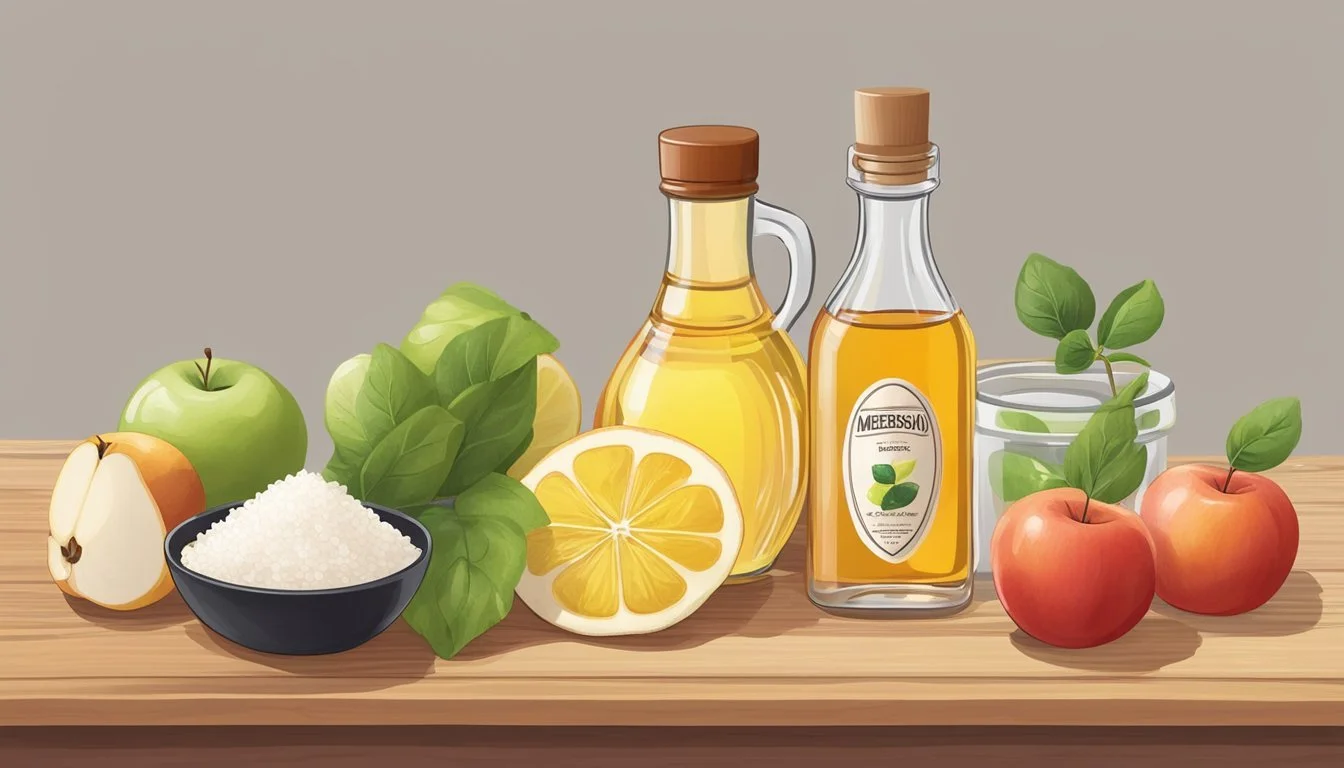Umeboshi Vinegar Substitutes
Top Alternatives for Your Cooking Needs
Umeboshi vinegar, also known as ume plum vinegar, is a byproduct of the umeboshi (pickled ume fruit) making process. It is a Japanese condiment that possesses a unique combination of tartness and saltiness with a hint of fruity sweetness, often used to enhance the flavor of various dishes. Due to its distinctive taste, umeboshi vinegar brings a depth of flavor to dressings, pickles, and marinades, making it a cherished staple in many kitchens. However, it might not be readily available everywhere, prompting cooks and chefs to look for suitable substitutes that align with the original's flavor profile.
Several vinegar substitutes can be employed when umeboshi vinegar is not at hand. These substitutes include red wine vinegar, white wine vinegar, apple cider vinegar, and rice vinegar, all of which offer a similar acidic quality but with their own unique flavors. When selecting a substitute, it is essential to consider the desired taste outcome of the dish, as each vinegar imparts a different character. For a closer match, the salty and fruity aspects of umeboshi vinegar might be mimicked by tweaking the substitute vinegar with additional ingredients. This allows those who are either out of umeboshi vinegar or simply exploring new flavor combinations to still achieve a harmonious balance in their culinary creations.
Understanding Umeboshi Vinegar
Umeboshi vinegar, also known as ume plum vinegar, is a byproduct of the fermentation process used to make umeboshi plums. These plums are a staple in Japanese cuisine, cherished for their sour and salty flavor profile. The plums are pickled and left to ferment, which results in a tangy brine. This brine, rich in lactic acid, becomes the umeboshi vinegar.
Flavor Profile:
Taste: Predominantly tangy with a salty undercurrent.
Texture: Thin and watery.
Umami: Provides a subtle savory note.
Uses in Cuisine: Umeboshi vinegar is traditionally used in Asian and particularly Japanese dishes. It can be used to add acidity and a depth of umami flavor to dressings, dips, and sauces.
Acidity: The vinegar possesses a unique level of acidity that differs from other common types of vinegar. Its distinct sour taste is less sharp compared to vinegars like apple cider or red wine vinegar, making it a sought-after ingredient in certain recipes.
Nutritional Aspect: Umeboshi vinegar is low in calories and contains trace minerals from the umeboshi plums.
Fermentation Process:
Fermentation: Umeboshi plums are salted and left to ferment, producing lactic acid.
Result: The fermentation yields a vinegar that carries the essence of umeboshi while being versatile in use.
Umeboshi vinegar plays a significant role in adding complexity to dishes within Japanese and broader Asian cuisines. Its unique blend of tanginess, saltiness, and umami make it irreplaceable in some traditional recipes, although alternatives can be used where its specific flavor is not essential.
Reasons for Substituting Umeboshi Vinegar
Umeboshi vinegar, a tangy, salty condiment, may be substituted due to various factors ranging from its availability to specific dietary needs. The following subsections address the main reasons people may look for alternatives to this distinctive Japanese ingredient.
Availability
Umeboshi vinegar is a product of pickled ume fruits, a type of Japanese plum, and is not as readily accessible in all parts of the world as more common vinegars. Consumers might find it challenging to locate in local stores, especially outside of Asia or specialty markets. This scarcity prompts the need to find substitutes that offer a similar flavor profile and can be used in the same culinary applications.
Dietary Restrictions
Vegetarians and vegans often look for substitutes for umeboshi vinegar despite it being plant-based because some brands may include additives derived from fish or other animal products. Additionally, individuals with allergies might react to specific components present in umeboshi vinegar. These dietary restrictions necessitate the search for alternative ingredients.
Flavor Preferences
The distinct, bold flavor of umeboshi vinegar might not align with everyone's flavor preferences. Some may find its taste too intense or wish to experiment with different flavor notes in their cooking. These individuals can opt for milder vinegars or those with a different acidic or sweet balance to adjust dishes to their liking.
Health Considerations
Umeboshi vinegar can be high in sodium, which might be a concern for those monitoring their sodium intake for health reasons. Alternatives with lower sodium content can be favored for their health benefits. Moreover, those seeking certain nutritional properties may also choose substitutes that align better with their health objectives.
Popular Substitutes for Umeboshi Vinegar
When seeking alternatives to umeboshi vinegar, it is essential to consider the flavor profile and acidity of the substitutes. The following vinegars provide a variety of tastes that can enhance salad dressings, marinades, dips, and act as a general seasoning for different dishes.
Apple Cider Vinegar
Apple cider vinegar is a fruity substitute that brings a slightly tangy flavor with a hint of sweetness. It is versatile, making it suitable for a range of dishes. Begin with a one-to-one replacement and adjust to taste for dressings or marinades.
Red Wine Vinegar
With its robust and tangy essence, red wine vinegar is an excellent substitute that offers a rich acidity. It works particularly well in recipes requiring a sharper flavor. To mirror umeboshi vinegar's distinct taste, start with less and incrementally increase the amount used.
Rice Vinegar
Rice vinegar comes with a milder acidity and a subtle sweetness, resembling the gentle tang of umeboshi vinegar. Its flavor makes it an excellent substitute in Asian-style dishes, especially when used in equal parts to replace umeboshi vinegar.
White Wine Vinegar
White wine vinegar provides a bright acidity with a sophisticated flavor profile. It maintains the balance of taste in recipes without overpowering other ingredients, making it a good alternative in delicate sauces and dips.
Balsamic Vinegar
Balsamic vinegar offers a complex, sweet-tart flavor profile that is far more pronounced than umeboshi vinegar. Use sparingly when substituting, as its rich taste and dark color might alter the appearance and flavor of the dish more significantly than other substitutes.
Other Vinegar Alternatives
Exploring alternatives to umeboshi vinegar leads to a variety of other vinegars that can complement the flavors in salads and other dishes with their distinctive sour taste.
Black Vinegar
Chinese black vinegar is a common substitute offering a malty flavor with a hint of sweetness. Its deep color and rich, smoky taste make it suitable for salad dressings where a pronounced sour note is desired. Due to its bold flavor, one should use it in smaller quantities initially and then adjust to taste.
Malt Vinegar
Malt vinegar, known for its robust and tangy profile, is a good alternative, especially in marinades and as a condiment for fries and fish. It is made from malted barley and has a lighter color than black vinegar. The sour taste is similar to umeboshi vinegar but with a distinct malt undertone.
Fruit Vinegars
Fruit vinegars are a diverse group that can replace umeboshi vinegar effectively. They range from apple cider vinegar, which is mildly fruity and tangy, to date vinegar, which has a sweet-sour profile. These vinegars are versatile in salad dressings and can infuse a dish with a fruity sharpness that echoes the essence of plum vinegar.
Non-Vinegar Replacements
When seeking alternatives for umeboshi vinegar that aren't vinegar-based, one can opt for ingredients that offer a combination of acidity and umami flavor. These alternatives are well-suited for various aspects of Asian cooking, including Japanese dishes.
Lemon or Lime Juice
Lemon juice and lime juice are excellent substitutes that provide the necessary acidity to mimic umeboshi vinegar's tang. They are commonly used in dressings and can serve as a base for dipping sauces.
Acidity: High
Best used in: Salads, marinades
Substitute ratio: Use a 1:1 ratio, then adjust for taste
Tamarind Paste
Tamarind paste is a prominent ingredient in Asian cooking that offers a tart, fruity flavor. It carries both sweetness and acidity, making it useful in more complex dishes that require depth.
Flavor profile: Tart, sweet
Best used in: Sauces, chutneys
Substitute ratio: Start with half the amount of umeboshi vinegar called for and taste as you go.
Fish Sauce
Fish sauce is a potent source of umami flavor. Derived from fermented fish, it adds depth to dishes without overwhelming with acidity.
Umami level: High
Best used in: Soups, stir-fries
Substitute ratio: Due to its strong flavor, use sparingly. Begin with a few drops and increase as needed.
Soy Sauce
Soy sauce offers a salty, umami-rich alternative. It works well in a variety of dishes where a balance of saltiness and umami is desired.
Umami level: Moderate to high
Best used in: Marinades, dressings
Substitute ratio: Use a lower amount than umeboshi vinegar and adjust for taste and salt content.
Shiso Leaves
Shiso leaves provide a unique flavor similar to a mix of mint, basil, and anise. While not acidic, they add a distinctive taste to dishes that umeboshi vinegar might be used in.
Flavor profile: Herbaceous, with hints of mint
Best used in: Garnishes, salads
Substitute ratio: Chopped shiso leaves can be sprinkled directly onto dishes as per preference.
DIY Umeboshi Vinegar Mix
Creating a homemade mix to replicate the unique flavor profile of umeboshi vinegar is possible with the right ingredients. These DIY substitutes bring the characteristic umami taste to various Japanese dishes.
Homemade Plum Vinegar
To craft a Homemade Plum Vinegar, one needs ripe plums, sugar, and distilled white vinegar. The process begins by washing the plums and removing their pits. The plums are then sliced and placed into a sterilized jar, alternating layers of fruit with sugar. Distilled white vinegar is poured over the plums until they are completely submerged. The concoction should be stored in a cool, dark place for about 4 weeks, during which the natural fermentation will infuse the vinegar with plum flavors.
Ingredients:
Ripe plums
Sugar
Distilled white vinegar
Instructions:
Wash and pit the plums.
Slice plums and layer in a jar with sugar.
Cover with distilled white vinegar.
Store for 4 weeks, then strain.
Mixed Vinegar Blend with Umami
A Mixed Vinegar Blend can be created by combining multiple vinegars and umeboshi paste, known for its umami essence. This blend mimics the complex taste of ume vinegar. Use a combination of 2 teaspoons of fish sauce and 4 teaspoons of balsamic vinegar as a base to achieve a similar flavor profile to umeboshi vinegar. Umeboshi paste can also be stirred into this base to intensify the umami flavor, if available.
Blend Composition:
Fish sauce
Balsamic vinegar
Optional: Umeboshi paste for added umami
Mixing Procedure:
Combine 2 tsp of fish sauce with 4 tsp of balsamic vinegar.
Mix well.
Add a small amount of umeboshi paste for enhanced flavor (optional).
Using Umeboshi Vinegar Substitutes in Cooking
When cooking with umeboshi vinegar substitutes, chefs seek to replicate its distinctive tartness and saltiness. These substitutes deliver a similar umami kick, enhancing flavors in a variety of dishes from salads to sushi.
Salads and Dressings
A chef may choose apple cider vinegar or rice vinegar to maintain the lightness of a salad dressing. These vinegars bring a brightness that complements fresh greens without overwhelming them.
Apple Cider Vinegar: versatile, with a fruity hint
Rice Vinegar: milder, slightly sweet
To replace umeboshi vinegar in a dressing:
Umeboshi Vinegar Apple Cider Vinegar Rice Vinegar 1 tbsp 1 tbsp + pinch of salt 1 tbsp
Marinades and Sauces
In marinades and sauces, red wine vinegar or white wine vinegar are excellent substitutes for umeboshi vinegar, as they add both acidity and complexity. Their robust profiles stand up to richer flavors in meat dishes or deeply savory sauces.
Red Wine Vinegar: strong, robust
White Wine Vinegar: softer, sophisticated
For a marinade substitution:
Umeboshi Vinegar Red Wine Vinegar White Wine Vinegar 1 tbsp 1 tbsp + pinch of salt 1 tbsp + pinch of salt
Sushi and Asian Dishes
In sushi and other Asian dishes, chefs often use umeboshi vinegar for its unique taste. Black vinegar or balsamic vinegar can be used as substitutes, especially in stir-fries and glazes, to provide a comparable depth.
Black Vinegar: earthy, deep
Balsamic Vinegar: rich, complex
When substituting in sushi or glazes, use less of the substitute vinegar, as their flavors are more concentrated:
Umeboshi Vinegar Black Vinegar Balsamic Vinegar 1 tsp 1/2 tsp 1/2 tsp
The chosen substitutes should reflect the same balance of saltiness and acidity that umeboshi vinegar provides, thus maintaining the intended flavor profile of the dish.
Health Considerations and Nutritional Comparison
When examining Umeboshi vinegar substitutes, it is important to assess not only the taste compatibility but also the health implications and nutritional content, particularly focusing on sodium content, acetic acid content, and antioxidant properties.
Sodium Content
Umeboshi vinegar is known for its high sodium content, which could affect blood pressure and cardiovascular health. Substitutes such as apple cider vinegar and rice vinegar tend to have lower sodium levels, benefiting those who are monitoring their sodium intake for health reasons. For a direct comparison, 2 teaspoons of fish sauce combined with 4 teaspoons of balsamic vinegar can mimic Umeboshi vinegar’s profile but should be used in moderation due to their potential high sodium content.
Acetic Acid Content
Acetic acid is a key component of vinegars, contributing to digestion and potentially aiding in regulating blood sugar levels. Umeboshi vinegar and its substitutes, including red wine vinegar and apple cider vinegar, contain varying levels of acetic acid, which may influence these health benefits. These substitutes must be used considering their acetic acid content to maintain a balance in meals.
Antioxidant Properties
Antioxidants are crucial in reducing oxidative stress, which has been linked to chronic diseases like cancer. Umeboshi vinegar has unique antioxidants due to the pickling of ume plums. Its substitutes provide different antioxidant profiles. Black vinegar, for instance, inherits antioxidant properties from its ingredients, like rice, which differ from Umeboshi vinegar but can still contribute to a diet high in antioxidants.
Finding Quality Substitutes
Selecting a high-quality substitute for Umeboshi vinegar requires attention to detail in label reading and understanding brand reputations for authenticity and purity.
Reading Labels
When choosing a substitute, one must carefully read labels to assess the content of organic acids, which are crucial for achieving a flavor profile similar to Umeboshi vinegar. For individuals with dietary restrictions, such as vegetarians and vegans, it's critical to verify that no animal-derived preservatives are included. Additionally, labels reveal the presence of unwanted chemicals or additives that should be avoided to maintain a natural flavor and healthfulness.
Organic Acids: Look for substitutes high in acetic or citric acid.
Preservatives: Avoid those with unfamiliar chemical names.
Vegetarian/Vegan: Ensure the label indicates suitability for these diets.
Brands and Authenticity
Identifying an authentic substitute involves researching brands renowned for their quality. A quality brand of vinegar substitute should have a reputation for using pure ingredients without unnecessary additives. One may also seek out brands specializing in organic products to ensure the absence of synthetic preservatives and chemicals.
Quality Brand: Research brands that prioritize natural ingredients and traditional production methods.
Authenticity is paramount when it comes to flavor and food safety. Brands with a transparent production process and clear ingredient sourcing are more likely to provide a substitute that mirrors the unique umami profile and tartness of Umeboshi vinegar.
Authenticity: Select substitutes from brands that disclose their ingredient sources and production practices.
Frequently Asked Questions (FAQs)
This section addresses common inquiries regarding substitutes for ume plum vinegar, their storage and shelf life, and their impact on traditional recipes. It aims to provide clear and fact-based information to enhance the use of ume plum vinegar alternatives in various cuisines.
Substitutes for Specific Dishes
Asian Cooking: When replacing ume plum vinegar in Asian dishes, one can opt for rice vinegar or apple cider vinegar to maintain a similar acidity and subtle fruitiness. For instance:
Sushi Rice: Use rice vinegar mixed with a pinch of salt and sugar to mimic the flavor profile.
Salad Dressings: Apple cider vinegar can offer a fruity tang that complements leafy greens.
Western Cuisine: Balsamic vinegar is a suitable substitute in western dishes, providing a robust flavor. It is important to start with smaller quantities as balsamic vinegar is stronger in taste.
Meat Marinades: Substitute with equal parts of balsamic vinegar.
Vinaigrettes: Mix with olive oil and herbs for an Italian-inspired dressing.
Storage and Shelf Life
Storage: Substitutes for ume plum vinegar should be stored in a cool, dark place to maintain their quality. Bottles should be tightly sealed to prevent oxidation.
Vinegar-Based Substitutes: These generally have a long shelf life when stored properly.
Umeboshi Paste: This should be kept refrigerated once opened.
Shelf Life: Most vinegar substitutes have an indefinite shelf life due to their acidic nature. However, their quality is best when used within:
Rice, Apple Cider, and Red Wine Vinegars: Ideally within 2 years.
Balsamic Vinegar: Can be aged for several years, enhancing its flavor and value.
Impact on Traditional Recipes
Japanese Cooking: Utilizing substitutes in Japanese cooking requires sensitivity to the balance of flavors. While substitutes can provide similar acidity and umami, they may alter the traditional taste.
Substitute Impact: Use substitutes sparingly to retain the integrity of the dish.
Preserving Traditions: When the authentic flavor is crucial, it's best to source ume plum vinegar whenever possible.
In other cuisines, the impact of using vinegar substitutes may be less pronounced and can often be adjusted to suit individual taste preferences.
Conclusion
When seeking to replace Umeboshi vinegar in a recipe, one has a variety of vinegar substitutes that can be utilized to deliver a comparable umami profile and acidity. These substitutes offer cooks confidence in the kitchen, allowing them to make informed choices that best suit the flavors of their dish.
Fish sauce and balsamic vinegar: A blend of these two condiments mirrors the umami depth and tartness of Umeboshi vinegar. Use 2 teaspoons of fish sauce mixed with 4 teaspoons of balsamic vinegar to substitute for a ¼ cup of Umeboshi vinegar.
The following vinegars also serve as effective replacements:
Red wine vinegar: Excels in dishes that benefit from a fruity, robust flavor.
White wine vinegar: Offers a lighter tartness, suitable for vinaigrettes and seafood dishes.
Apple cider vinegar: Brings a subtle fruit note and gentle acidity, great for dressings and marinades.
Rice vinegar: Provides a mild sweetness, perfect for Asian-inspired recipes.
Black vinegar: Contributes a deep, smoky essence, often used in braised dishes and sauces.
Cooks have the liberty to experiment with these substitutes to match the desired sourness and complexity of Umeboshi vinegar. Whether one is shopping at local co-ops or larger grocery chains, these alternatives are typically available and can be proportionally adjusted to cater to the dish's flavor profile.













